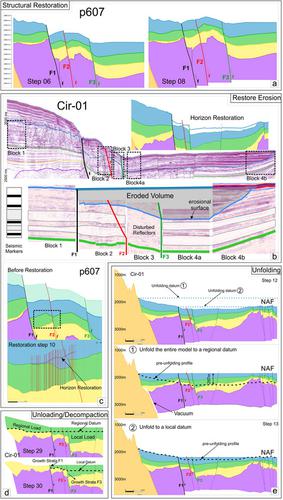当前位置:
X-MOL 学术
›
Basin Res.
›
论文详情
Our official English website, www.x-mol.net, welcomes your
feedback! (Note: you will need to create a separate account there.)
Assessing the rate of crustal extension by 2D sequential restoration analysis: A case study from the active portion of the Malta Escarpment
Basin Research ( IF 2.8 ) Pub Date : 2021-10-10 , DOI: 10.1111/bre.12621 Salvatore Gambino 1 , Giovanni Barreca 1, 2 , Felix Gross 3, 4 , Carmelo Monaco 1, 2, 5 , Marc‐André Gutscher 6 , G. Ian Alsop 7
Basin Research ( IF 2.8 ) Pub Date : 2021-10-10 , DOI: 10.1111/bre.12621 Salvatore Gambino 1 , Giovanni Barreca 1, 2 , Felix Gross 3, 4 , Carmelo Monaco 1, 2, 5 , Marc‐André Gutscher 6 , G. Ian Alsop 7
Affiliation

|
Tectono-stratigraphic interpretation and sequential restoration modelling was performed over two high-resolution seismic profiles crossing the Western Ionian Basin of southern Italy. This analysis was undertaken in order to provide greater insights and a more reliable assessment of the deformation rate affecting the area. Offshore seismic profiling illuminates the sub-seafloor setting where a belt of active normal faults slice across the foot of the Malta Escarpment, a regional-scale structural boundary inherited from the Permo-Triassic palaeotectonic setting. A sequential restoration workflow was established to back-deform the entire investigated sector with the primary aim of analysing the deformation history of the three major normal faults affecting the area. Restoration of the tectono-stratigraphic model reveals how deformation rates evolved through time. In the early stage, the studied area experienced a significant deformation with the horizontal component prevailing over the vertical element. In this context, the three major faults contribute to only one third of the total deformation. The overall throw and extension then notably reduced through time towards the present day and, since the middle Pliocene, ongoing crustal deformation is accommodated almost entirely by the three major normal faults. Unloading and decompaction indicate that when compared to the unrestored seismic sections, a revision and a reduction of roughly one third of the vertical displacement of the faults offset is required. This analysis ultimately allows us to better understand the seismic potential of the region.
中文翻译:

通过二维顺序恢复分析评估地壳延伸率:来自马耳他悬崖活动部分的案例研究
对穿越意大利南部西爱奥尼亚盆地的两个高分辨率地震剖面进行了构造地层解释和顺序恢复建模。进行这项分析是为了提供更深入的见解和更可靠地评估影响该地区的变形率。近海地震剖面揭示了海底环境,活动的正断层带穿过马耳他悬崖脚下,这是一个继承自二叠纪-三叠纪古构造环境的区域尺度结构边界。建立顺序恢复工作流程以对整个调查扇区进行反变形,主要目的是分析影响该区域的三个主要正断层的变形历史。构造地层模型的恢复揭示了变形率如何随时间演变。早期,研究区经历了明显的变形,水平分量超过了垂直分量。在这种情况下,三大断层只贡献了总变形的三分之一。随着时间的推移,到今天,总的断距和伸展显着减少,并且自上新世中期以来,持续的地壳变形几乎完全由三个主要的正断层适应。卸载和解压表明,与未恢复的地震剖面相比,需要修正和减少大约三分之一的断层偏移垂直位移。这种分析最终使我们能够更好地了解该地区的地震潜力。早期,研究区经历了明显的变形,水平分量超过了垂直分量。在这种情况下,三大断层只贡献了总变形的三分之一。随着时间的推移,到今天,总的断距和伸展显着减少,并且自上新世中期以来,持续的地壳变形几乎完全由三个主要的正断层适应。卸载和解压表明,与未恢复的地震剖面相比,需要修正和减少大约三分之一的断层偏移垂直位移。这种分析最终使我们能够更好地了解该地区的地震潜力。早期,研究区经历了明显的变形,水平分量超过了垂直分量。在这种情况下,三大断层只贡献了总变形的三分之一。随着时间的推移,到今天,总的断距和伸展显着减少,并且自上新世中期以来,持续的地壳变形几乎完全由三个主要的正断层适应。卸载和解压表明,与未恢复的地震剖面相比,需要修正和减少大约三分之一的断层偏移垂直位移。这种分析最终使我们能够更好地了解该地区的地震潜力。研究区域经历了明显的变形,水平分量超过了垂直分量。在这种情况下,三大断层只贡献了总变形的三分之一。随着时间的推移,到今天,总的断距和延伸量显着减少,并且自上新世中期以来,正在进行的地壳变形几乎完全由三个主要的正断层适应。卸载和解压表明,与未恢复的地震剖面相比,需要修正和减少大约三分之一的断层偏移垂直位移。这种分析最终使我们能够更好地了解该地区的地震潜力。研究区域经历了明显的变形,水平分量超过了垂直分量。在这种情况下,三大断层只贡献了总变形的三分之一。随着时间的推移,到今天,总的断距和延伸量显着减少,并且自上新世中期以来,正在进行的地壳变形几乎完全由三个主要的正断层适应。卸载和解压表明,与未恢复的地震剖面相比,需要修正和减少大约三分之一的断层偏移垂直位移。这种分析最终使我们能够更好地了解该地区的地震潜力。随着时间的推移,到今天,总的断距和延伸量显着减少,并且自上新世中期以来,正在进行的地壳变形几乎完全由三个主要的正断层适应。卸载和解压表明,与未恢复的地震剖面相比,需要修正和减少大约三分之一的断层偏移垂直位移。这种分析最终使我们能够更好地了解该地区的地震潜力。随着时间的推移,到今天,总的断距和延伸量显着减少,并且自上新世中期以来,正在进行的地壳变形几乎完全由三个主要的正断层适应。卸载和解压表明,与未恢复的地震剖面相比,需要修正和减少大约三分之一的断层偏移垂直位移。这种分析最终使我们能够更好地了解该地区的地震潜力。需要修正并减少大约三分之一的断层偏移垂直位移。这种分析最终使我们能够更好地了解该地区的地震潜力。需要修正并减少大约三分之一的断层偏移垂直位移。这种分析最终使我们能够更好地了解该地区的地震潜力。
更新日期:2021-10-10
中文翻译:

通过二维顺序恢复分析评估地壳延伸率:来自马耳他悬崖活动部分的案例研究
对穿越意大利南部西爱奥尼亚盆地的两个高分辨率地震剖面进行了构造地层解释和顺序恢复建模。进行这项分析是为了提供更深入的见解和更可靠地评估影响该地区的变形率。近海地震剖面揭示了海底环境,活动的正断层带穿过马耳他悬崖脚下,这是一个继承自二叠纪-三叠纪古构造环境的区域尺度结构边界。建立顺序恢复工作流程以对整个调查扇区进行反变形,主要目的是分析影响该区域的三个主要正断层的变形历史。构造地层模型的恢复揭示了变形率如何随时间演变。早期,研究区经历了明显的变形,水平分量超过了垂直分量。在这种情况下,三大断层只贡献了总变形的三分之一。随着时间的推移,到今天,总的断距和伸展显着减少,并且自上新世中期以来,持续的地壳变形几乎完全由三个主要的正断层适应。卸载和解压表明,与未恢复的地震剖面相比,需要修正和减少大约三分之一的断层偏移垂直位移。这种分析最终使我们能够更好地了解该地区的地震潜力。早期,研究区经历了明显的变形,水平分量超过了垂直分量。在这种情况下,三大断层只贡献了总变形的三分之一。随着时间的推移,到今天,总的断距和伸展显着减少,并且自上新世中期以来,持续的地壳变形几乎完全由三个主要的正断层适应。卸载和解压表明,与未恢复的地震剖面相比,需要修正和减少大约三分之一的断层偏移垂直位移。这种分析最终使我们能够更好地了解该地区的地震潜力。早期,研究区经历了明显的变形,水平分量超过了垂直分量。在这种情况下,三大断层只贡献了总变形的三分之一。随着时间的推移,到今天,总的断距和伸展显着减少,并且自上新世中期以来,持续的地壳变形几乎完全由三个主要的正断层适应。卸载和解压表明,与未恢复的地震剖面相比,需要修正和减少大约三分之一的断层偏移垂直位移。这种分析最终使我们能够更好地了解该地区的地震潜力。研究区域经历了明显的变形,水平分量超过了垂直分量。在这种情况下,三大断层只贡献了总变形的三分之一。随着时间的推移,到今天,总的断距和延伸量显着减少,并且自上新世中期以来,正在进行的地壳变形几乎完全由三个主要的正断层适应。卸载和解压表明,与未恢复的地震剖面相比,需要修正和减少大约三分之一的断层偏移垂直位移。这种分析最终使我们能够更好地了解该地区的地震潜力。研究区域经历了明显的变形,水平分量超过了垂直分量。在这种情况下,三大断层只贡献了总变形的三分之一。随着时间的推移,到今天,总的断距和延伸量显着减少,并且自上新世中期以来,正在进行的地壳变形几乎完全由三个主要的正断层适应。卸载和解压表明,与未恢复的地震剖面相比,需要修正和减少大约三分之一的断层偏移垂直位移。这种分析最终使我们能够更好地了解该地区的地震潜力。随着时间的推移,到今天,总的断距和延伸量显着减少,并且自上新世中期以来,正在进行的地壳变形几乎完全由三个主要的正断层适应。卸载和解压表明,与未恢复的地震剖面相比,需要修正和减少大约三分之一的断层偏移垂直位移。这种分析最终使我们能够更好地了解该地区的地震潜力。随着时间的推移,到今天,总的断距和延伸量显着减少,并且自上新世中期以来,正在进行的地壳变形几乎完全由三个主要的正断层适应。卸载和解压表明,与未恢复的地震剖面相比,需要修正和减少大约三分之一的断层偏移垂直位移。这种分析最终使我们能够更好地了解该地区的地震潜力。需要修正并减少大约三分之一的断层偏移垂直位移。这种分析最终使我们能够更好地了解该地区的地震潜力。需要修正并减少大约三分之一的断层偏移垂直位移。这种分析最终使我们能够更好地了解该地区的地震潜力。











































 京公网安备 11010802027423号
京公网安备 11010802027423号